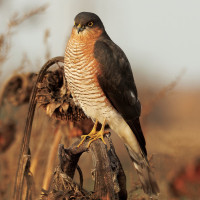Beschreibung
Lambert's Castle is a relatively flat area on top of 840 foot high hill, the site is owned and managed by the National Trust (NT), it is designated as a Site of Special Scientific Interest (SSSI). The site comprises of grassland, heathland (Calluna/Erica), Bilberry (Vaccinium), Gorse (Ulex), Bramble (Rubus), Birch (Betula), Hawthorn (Crataegus), Rowan (Sorbus), Oak (Quercus), Beech (Fagus), Scots Pine (Pinus) and Larch (Larix). Unsurprisingly with the area having a good number of tree species, the bird species can be quite diverse, including Sumpfmeise, Fichtenkreuzschnabel, Dorngrasmücke, Fitis, Zilpzalp, Schwarzkehlchen, Bluthänfling, Wiesenpieper, Grauschnäpper, Trauerschnäpper and Gartenrotschwanz.
For more information PRESS Stars on map.
Details
Zugang
The main road running from Honiton (far to the West) and Bridport (far to the East) runs just to the South of the site. From Honiton leave Eastwards on A35 signed Axminster/Bridport. Bypassing the town of Axminster continue on A35, on the outskirts of Raymond's Hill turn Left signed Crewkerne B3165, (*A) continue on slowly climbing B3165 and car park is on Right with wide entrance. From Bridport leave Westwards on A35, pass through Chideock on A35, continue to follow signs to Honiton, in Raymond's Hill turn Right signed Crewkerne B3165 and follow from (*A) above.


